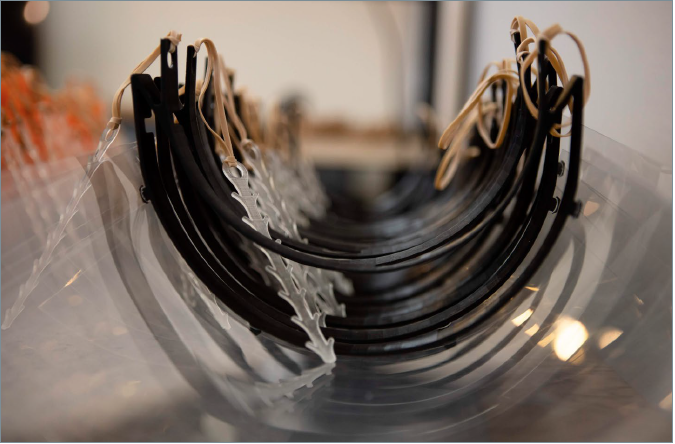Background
Today, under normal circumstances, face shields are used by millions of people. In addition to medical workers, they are utilized by dental providers, veterinarians, laboratory workers, emergency medical technicians, police, firefighters, and cleaning crews who deal with spills and contaminated waste. With the onset of the pandemic, they are also being worn by workers at utilities, logistics, retail, and other essential businesses.
Face masks have been shown to significantly reduce the risk of inhalation and other forms of contact with infectious pathogens. In fact, several studies have shown them to reduce specific types of viral exposure by 68% to as much as 96%. Further, they are typically more comfortable to wear and reduce the risk of autoinoculation by preventing the user from touching their face.
Traditional manufacturers of face shields include companies like Honeywell, 3M, and Medline Industries. They are typically sold to hospitals and health care providers by medical providers. In the face of the pandemic however, others have leaned in and are now producing face masks. Some of the more notable companies include Apple, Nike, SpaceX, Ford, and Amazon.

Technician wearing 3D printed face mask.
The Challenge
Technician wearing 3D printed face mask.Since the onset of the COVID 19 pandemic, demand for personal protective equipment (PPE) has increased rapidly. In addition to healthcare professionals, first responders and other essential workers are taking additional precautions to minimize the risk of infection. As a result, supply chains are overwhelmed and organizations everywhere are scrambling to ensure their employees are properly protected.
Of particular concern is a shortage of facial protection. In many cases front line workers use face masks either in place of or in addition to surgical masks. Face shields can take many forms, but typically provide a clear plastic barrier that covers the wearer’s eyes, nose and mouth, helping protect users from contact with infected droplets.
The Solution
As with other critical supplies needed in the fight against COVID 19, the additive manufacturing industry has also answered the call. Many efforts are now underway, from grassroots programs powered by owners of desktop 3D printers, to larger initiatives led by some of the biggest names in the industry.
One example is Nexa3D’s recent announcement regarding their plans to produce protective gear for healthcare and other essential workers. Established as a direct response to the urgent requests for PPE pouring in from healthcare facilities as well as other essential front line workers, Nexa3D partnered with key players in the medical industry to develop a face shield that is lightweight and designed to be worn for long periods of time while limiting facial exposure to aerosol and splatter.

Face shield frames being produced on a Nexa3D NXE400 3D printer.
Recently, Nexa3D joined Henkel’s Open Materials Platform. Soon after, the two companies announced their initial collaboration with the availability of Nexa3D 3843 xABS Black, which is based on LOCTITE 3D 3843 and optimized to run smoothly on Nexa3D’s machines. The company’s NXE400 printers are powered by it’s proprietary Lubricant Sublayer Photo curing (LSPc) technology and patented structured light matrix, allowing them to produce up to 19 liters of part volume at high speed, thereby reducing the time it takes to produce functional prototypes and production parts, often from hours to just minutes.
“We believe that the additive manufacturing industry is uniquely positioned to deliver practical, urgent, and scalable solutions during this unprecedented crisis that address the severely broken supply chain,” said Nexa3D CEO Avi Reichental. “At Nexa3D, we have deep partnerships that we can leverage, and we have a commitment to caring for our community.”
Nexa3D has already manufactured and distributed face shields to workers at several medical facilities including Cottage Health System in Santa Barbara, California. They’ve also provided them for the Santa Barbara Bucket Brigade, a non-profit association that assists with disaster recovery, delivering shields and masks to first responders and other front line workers.

Finished face shields ready for distribution
Henkel’s Open Materials Platform and focus on agile innovation allows it to work closely with Nexa3D and many of the other leading equipment providers in the additive manufacturing space. This enables them to quickly solve big problems by eliminating the long lead times and supply chain strain involved with traditional processes. In the present environment, this is helping thousands of front line workers get the PPE they need to safely treat and support those impacted by COVID 19.
As new challenges arise, industry collaborations like those offered by Henkel’s Open Materials Platform will be available to help companies quickly react and meet the need. And when a new situation does arise, the experience gleaned from this emergency will prove beneficial in helping others better leverage the benefits of additive manufacturing in the future.
For more information on Nexa3D printers please click the button below.







Leave A Comment